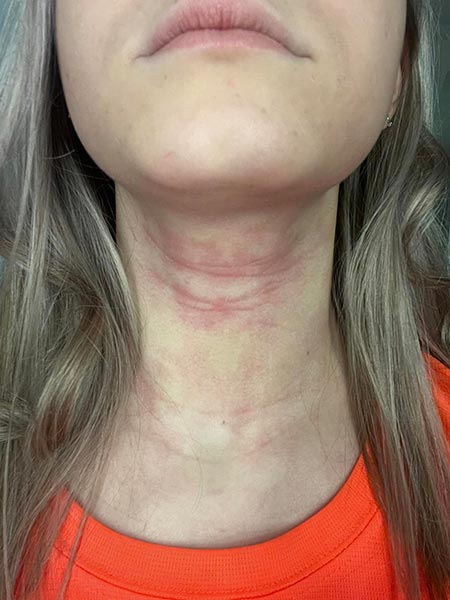Is Snail Mucin Safe for Eczema-Prone Skin: A Comprehensive Guide
Eczema is a chronic skin condition that affects millions of people globally, causing discomfort and distress due to itching, dryness, and irritation. With the rise in popularity of natural skincare remedies, snail mucin has gained attention as a potential solution for sensitive and eczema-prone skin. But is snail mucin safe for eczema? This article explores the benefits, risks, and practical applications of snail mucin for those dealing with this challenging condition.


One week later using the Atopic Cream.
What Is Snail Mucin?
The Origins of Snail Mucin in Skincare
Snail mucin, also referred to as snail secretion filtrate, originates from the natural mucus secreted by snails. This secretion was initially recognized for its healing properties when snail farmers in Chile noticed improved skin quality and faster healing of wounds on their hands. Today, snail mucin is a cornerstone ingredient in Korean beauty products and has spread globally due to its multifunctional benefits.
Composition of Snail Mucin: Nutrients and Properties
Snail mucin is packed with powerful skin-rejuvenating ingredients, including:
- Hyaluronic acid: Retains moisture, keeping skin hydrated.
- Glycolic acid: Promotes gentle exfoliation and skin renewal.
- Allantoin: Soothes and calms irritated skin.
- Peptides and proteins: Aid in skin repair and elasticity.
- Antioxidants: Help combat free radical damage.
These components make snail mucin a versatile ingredient for addressing multiple skin concerns, from dryness to acne scars.
Understanding Eczema and Eczema-Prone Skin
What Causes Eczema?
Eczema, or atopic dermatitis, is a complex condition caused by a combination of genetic predisposition and environmental factors. Common triggers include:
- Harsh weather conditions
- Allergens like pollen or dust
- Irritants in skincare or detergents
- Stress or hormonal fluctuations
Challenges of Eczema-Prone Skin
Eczema-prone skin is characterised by a compromised skin barrier, leading to increased sensitivity, dryness, and a heightened risk of infections. This delicate balance makes it crucial to choose skincare products that repair rather than irritate the skin.
Common Treatments and Their Limitations
Standard treatments include corticosteroids, antihistamines, and medicated creams. While effective, these options often come with side effects such as thinning skin, dependency, or limited efficacy over time. This is where natural alternatives like snail mucin come into play, offering a gentler approach to skin repair and hydration.
The Science Behind Snail Mucin for Eczema
Anti-Inflammatory Properties
One of the standout benefits of snail mucin is its ability to reduce inflammation. Its anti-inflammatory compounds help calm redness and irritation, two hallmark symptoms of eczema. By soothing the skin, snail mucin can contribute to a more comfortable and less inflamed appearance.
Hydration Benefits and Skin Barrier Repair
Eczema-prone skin often lacks the ability to retain moisture effectively. Snail mucin is rich in hyaluronic acid, a molecule known for its superior hydration capabilities. By locking in moisture, it helps strengthen the skin barrier, reducing the risk of flare-ups.
Role of Glycolic Acid in Gentle Exfoliation
Unlike harsh chemical exfoliants, the glycolic acid in snail mucin provides gentle exfoliation. This process removes dead skin cells, preventing build-up that can aggravate eczema while promoting a smoother texture.
Clinical Studies and Dermatologists’ Insights
Evidence Supporting Snail Mucin for Sensitive Skin
Scientific studies have demonstrated the efficacy of snail mucin in promoting skin regeneration, reducing scars, and improving hydration. For example, research highlights its ability to accelerate wound healing and support collagen production, making it a promising ingredient for sensitive or damaged skin.
Potential Risks and Allergic Reactions
While snail mucin is generally well-tolerated, it is not entirely risk-free. Individuals with very sensitive skin may experience mild irritation or allergic reactions. Dermatologists often recommend conducting a patch test before introducing snail mucin into a routine, especially for eczema sufferers.
How to Use Snail Mucin Safely for Eczema-Prone Skin
Choosing the Right Snail Mucin Product
Not all snail mucin products are created equal. Look for high-quality formulations that are:
- Fragrance-free: Avoids unnecessary irritation.
- Paraben-free: Reduces the risk of harmful side effects.
- Dermatologist-tested: Ensures suitability for sensitive skin.
Ingredients to Look For
- Ceramides for barrier repair
- Aloe vera for soothing benefits
- Niacinamide for anti-inflammatory effects
Avoiding Irritants and Additives
Ingredients like alcohol, artificial fragrances, and harsh preservatives should be avoided, as they can exacerbate eczema symptoms.
Patch Testing: Why It’s Important
Patch testing involves applying a small amount of the product to an inconspicuous area of the skin, such as the inner arm. After 24–48 hours, any signs of redness, itching, or swelling should indicate whether the product is safe to use.
How Often Should You Use It?
Begin by applying snail mucin 2–3 times per week. Gradually increase frequency based on your skin’s tolerance. Consistency is key for seeing long-term benefits.
Snail Mucin vs. Traditional Eczema Treatments
Comparison of Effectiveness
Snail mucin excels in improving hydration and calming inflammation but may not replace corticosteroids or prescription creams for severe eczema. It works best as a complementary treatment.
Side Effects and Long-Term Safety
Unlike corticosteroids, which can thin the skin with prolonged use, snail mucin is considered safe for long-term application. Its gentle nature makes it ideal for sensitive and eczema-prone skin.
Real-Life Testimonials and Case Studies
Success Stories with Snail Mucin
Numerous users report noticeable improvements in hydration, reduced redness, and fewer flare-ups after incorporating snail mucin into their skincare routine.
Common Challenges Users Encounter
Some individuals find the texture sticky or notice slower results compared to traditional treatments. However, patience and proper product selection often lead to positive outcomes.
FAQs About Snail Mucin and Eczema-Prone Skin
- Can Snail Mucin Be Used Daily?
Yes, but start gradually to ensure your skin adapts. - Is Snail Mucin Suitable for Children with Eczema?
Consult a paediatric dermatologist before use. - Does Snail Mucin Cause Irritation?
Rarely, but patch-testing can help identify potential issues. - What Other Skin Conditions Benefit from Snail Mucin?
Conditions like acne scars, rosacea, and sun damage may also improve. - How Long Before You See Results?
Results typically appear within 4–6 weeks of consistent use. - Where Can You Buy Quality Snail Mucin Products?
Look for reputable brands online or in trusted skincare stores.
Conclusion: Is Snail Mucin Right for You?
Snail mucin is a safe, natural, and effective option for many eczema sufferers. Its ability to hydrate, soothe, and repair makes it a valuable addition to a skincare routine. However, as with any product, individual responses vary. Consult with a dermatologist for tailored advice, and always prioritise patch testing.
Atopic Cream for Sensitive Skin
Our atopic cream is designed to treat skin conditions. These may be inherited or as a result of sensitivity to allergens such as soaps, detergents, stress and the weather. Made from snail mucin – a natural ingredient with a wealth of healing, hydrating, and anti-inflammatory properties. Our Atopic Cream is dermatologically tested and effective in treating chronic skin conditions including eczema, psoriasis, and dermatitis. It brings relief to those suffering from irritated or itchy skin, rashes and allergic reactions. Snail mucin also reduces scar tissue and stretch marks and is soothing for dry and sensitive skin. Incorporate snail mucin cream…
Featured Bragan Skincare Products
-
€39.99 – €100.00Price range: €39.99 through €100.00Select options This product has multiple variants. The options may be chosen on the product page
-
€100.00Select options This product has multiple variants. The options may be chosen on the product page


